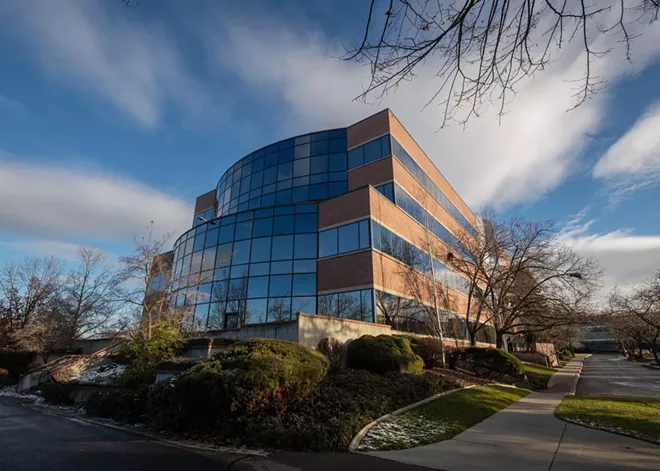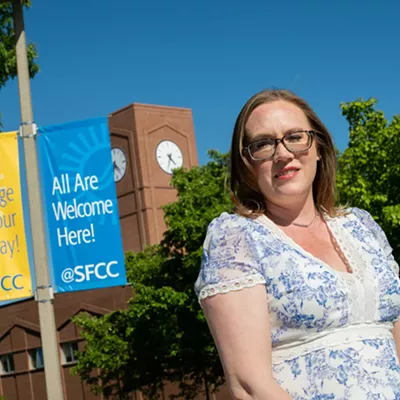
Last year, Spokane voters rejected Spokane Public Schools' $200 million bond, which would have funded school replacements and updates at some of the oldest buildings in the district. While other school districts in the region opted to rerun their bonds in November — Cheney Public Schools passed its bond on the second attempt, while Deer Park and Lakeland joint school districts' efforts failed again — the Spokane School Board decided to wait.
Though the bond's failure caused the district to reconsider how it presents future funding asks, it also presented an opportunity that the bond would not have paid for, had it been passed. Last month, the SPS Board made the unanimous decision to buy a building in the city's University District from the Community Colleges of Spokane Foundation.
"With the bond not passing, we had to start over. If it had passed, I don't know that we would be looking at this purchase," Spokane School Board President Nikki Otero Lockwood says. "To build a new school, or even to build a new [administrative] building, it's $50-$60 million. This building is just $12.2 million."
The district's move to its newly purchased five-story building at 501 N. Riverpoint Blvd. is still years away, but the intention behind the acquisition is to consolidate its administrative footprint.
"That building went up for sale, and it was of interest for a couple of reasons. I think the Superintendent [Adam Swinyard] is always looking at how to update our facilities, and he's thinking of consolidation, too," Otero Lockwood says. "For those two reasons, he thought that might be a good fit for us, and it will be a cost savings."
Those cost-savings intrigued the School Board, she says. With the intent to house administrative staff in the Riverpoint building, the district eventually plans to sell its current administrative building and parking lot at 200 N. Bernard St. While it'll take a few years for the district to move into the purchased building, it'll be able to collect revenue from the current Riverpoint tenants, including the Community Colleges of Spokane and a few other businesses.
The district could also eventually move the Community School, which operates in an old elementary school building at 1025 W. Spofford Ave., into the U-District building.
"You know, we didn't pass the bond, and even if we did, we weren't able to meet the request of the Community School in particular to have a building within the U-District community. [It] just wasn't within the scope of what we could do with the bond," Otero Lockwood says. "[The Community School is] in an old elementary school facility, and it does not fit a 21st century learning environment for a project-based school. To be nested in with higher education is good access and proximity for our students there as well."
Otero Lockwood emphasizes that no formal decisions have been made about what will go into the new building, and she says that the School Board will make those choices after hearing input from the community. (She says that public input will likely occur in a February meeting.)
'REDUCE OUR FOOTPRINT'
As Spokane Public Schools prepares to take up residence at 501 N. Riverpoint Blvd. in the next few years, the Community Colleges of Spokane is working to reduce its administrative footprint amid a strategic rebrand. To do that, it'll move out of the Riverpoint building it leased from the Community Colleges of Spokane Foundation (before the sale to the school district).
"We lease a major portion of the building from the foundation, so when I became chancellor close to two years ago now, one of the decisions I made was the idea to try to reduce the cost of leases that we have, as well as reduce our footprint," Community Colleges of Spokane Chancellor Kevin Brockbank says.
At its core, the choice to move out of the building presents cost savings. According to Brockbank, the Community Colleges of Spokane, which oversees Spokane Community College, or SCC, and Spokane Falls Community College, or SFCC, will see its operating costs reduced by more than $500,000 per year.
However, beyond cost savings Brockbank argues that the location in the U-District has no tangible benefits for the community colleges.
"This building has served as a place to meet and to do business, but what it unfortunately doesn't do is it doesn't serve students," Brockbank explains. "I've said this over and over again that one of the real great benefits about working at a college is being on a college campus. It's a fun place to be, it's energizing, and we don't get any of that here.
"We profess to be a mission-driven institution that's about student success, learning and benefiting our community," he continues. "If we have employees who work here at this site who never get a chance to see our mission, which is students learning, then we're not really living a mission-driven purpose."
When Community Colleges of Spokane moved into the building in 2000, it anticipated that the U-District location would help build relationships with other higher education institutions. And while those relationships have thrived over the years, Brockbank doesn't think that proximity to other university buildings is the reason for that.
"The reality of it is that our physical location is not what spawns our partnerships with WSU Spokane or Gonzaga or anybody else who's in this university district," he says. "Those things happen because of meetings and work everywhere. So the physical location, while symbolic, provides no real, tangible benefit that we couldn't get if we were in a different location."
Brockbank anticipates the move will happen in stages. He anticipates that five of the six departments, along with their 50 employees, will move to the SFCC campus by December 2026. Then by the end of 2027, the final department, with just fewer than 50 employees, will relocate to the SCC campus.
As the organization works to shrink its footprint, it's also undergoing a strategic rebranding, changing simply to "Spokane Colleges." This rebrand has been in progress for more than two years and was introduced by former Chancellor Christine Johnson, Brockbank says.
Over the last few weeks, billboards have gone up around Spokane announcing the new name alongside other changes, such as the shift in mascot from bigfoot to sasquatch.
"It was just time for us to have a refresh and a modern look. Our previous logo and brand was outdated, and I don't think very representative of who we are as an institution," Brockbank says. "We're really trying to make sure that we're visible and available to anybody who's interested in what we do. This is just a better representation for us of who we are." ♦




















